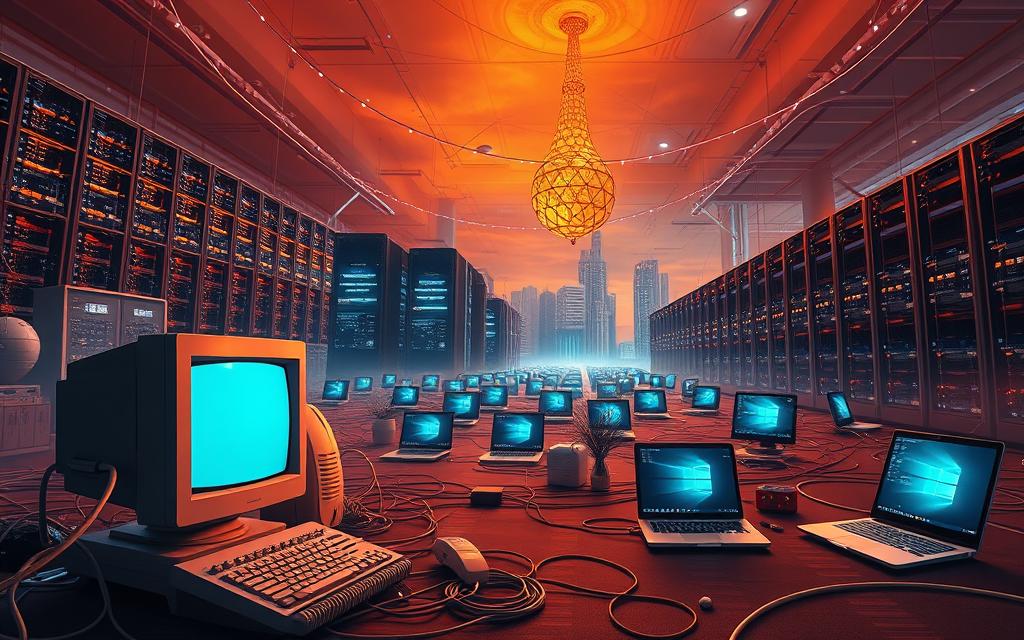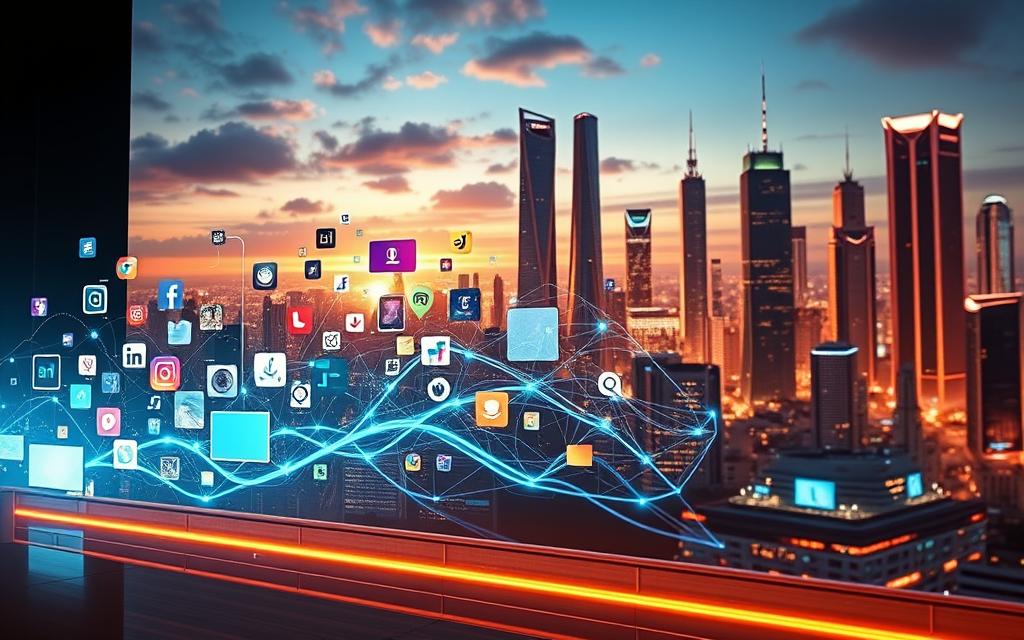Over recent decades, advancements have reshaped the way we live, work, and connect. Innovations today stand in stark contrast to the limitations of earlier years. From slow dial-up connections to lightning-fast 5G networks, the transformation has been remarkable.
Global adoption rates for smartphones, the internet, and AI have skyrocketed. Statista’s 2023 data reveals that 59.9% of the world’s population uses social media. This widespread connectivity has revolutionized communication, storage, and daily life.
Modern tools like cloud storage and IoT devices have replaced outdated methods. Streaming services and remote work platforms have also transformed industries. These shifts highlight the continuous acceleration of progress across various sectors.
To explore more about this evolution, visit our detailed guide on the evolution of technology. Discover how these changes impact society and shape the future.
Introduction: The Rapid Evolution of Technology
From the industrial revolution to the digital age, progress has been relentless. Over the last few decades, advancements have reshaped every aspect of life. Today, 95% of U.S. households have broadband, compared to just 25% in 2000. This shift highlights the transformative power of innovation.
Global smartphone adoption has reached 6.92 billion users in 2023. This widespread connectivity has redefined communication, work, and entertainment. Average internet speeds have also skyrocketed, from 56kbit/s in 2000 to 22Mbps today. These changes underscore the rapid pace of development.
The workforce has also seen significant transformation. Post-pandemic, 42% of employees work remotely. This shift reflects the growing reliance on digital tools and platforms. Similarly, the rise of IoT devices has connected billions of gadgets worldwide, with projections reaching 29 billion by 2030.
Economic impacts are equally profound. Global e-commerce reached $5.5 trillion in 2022, driven by digital innovation. Healthcare has also benefited, with AI diagnostics improving accuracy by 40%. However, challenges like e-waste, which hit 53.6 million metric tons in 2023, remind us of the need for sustainable solutions.
| Metric | 2000 | 2023 |
|---|---|---|
| Broadband Adoption (U.S.) | 25% | 95% |
| Global Smartphone Users | 0.1 billion | 6.92 billion |
| Average Internet Speed | 56kbit/s | 22Mbps |
These milestones set the stage for a deeper exploration of specific technological domains. From cloud storage to AI, the world continues to evolve at an unprecedented pace. The next sections will delve into these advancements, offering insights into their impact on society and the future.
The Internet: From Dial-Up to High-Speed Connectivity
From slow connections to blazing-fast speeds, the internet has evolved dramatically. Over the decades, it has become a vital part of daily life, transforming how we communicate, work, and access information.

The Era of Dial-Up Internet
In the 1990s, dial-up was the primary way to connect. Users experienced the iconic “You’ve Got Mail” notification from AOL, but the process was far from seamless. A 6MB file took 15 minutes to download, and phone lines were often tied up.
Technical limitations, like 56k modems, made browsing a slow and frustrating experience. Despite these challenges, dial-up laid the foundation for the global connectivity we enjoy today.
The Rise of Broadband and Wi-Fi
Broadband revolutionized internet access, offering faster speeds and always-on connections. U.S. household adoption grew from 44% in 2000 to 88% in 2023. Wi-Fi, introduced in 1997, further enhanced convenience, enabling wireless connectivity for every device.
Today, 5G networks deliver speeds up to 20Gbps, 100 times faster than 4G. The latest Wi-Fi 6 standard supports 9.6Gbps throughput, ensuring seamless streaming and remote work capabilities.
“The internet is no longer a luxury; it’s a necessity.”
Global internet users surged from 738 million in 2000 to 5.3 billion in 2023. This growth has fueled a $2.1 trillion U.S. digital economy, with 75% of companies relying on cloud collaboration tools. As infrastructure expands, with 7.3 million cell towers worldwide, the future looks even brighter. Predictions suggest 6G could achieve 1Tbps speeds by 2030, pushing boundaries further.
The Evolution of Communication
From handwritten letters to real-time video calls, communication has come a long way. Over the years, innovations have bridged distances and redefined how we connect. Today, instant messaging and video conferencing are integral to personal and professional interactions.
From Letters to Instant Messaging
The first SMS, sent in 1992, marked the beginning of a new era. Initially limited to 160 characters, messaging has evolved into rich media platforms like WhatsApp, which handles 23 billion daily messages in 2023. This shift reflects a cultural preference for texting over voice calls, with 68% of users favoring it.
Costs have also dropped significantly. In the 1980s, international calls cost $3 per minute. Today, VoIP services like Skype and WhatsApp offer free calls, making global communication accessible to all.
The Rise of Video Calling
Video calling has become a cornerstone of modern communication. Zoom, for instance, grew from 10 million to 300 million daily users during the pandemic. Businesses have embraced this trend, with 87% of companies now using video conferencing regularly.
Technologies like WebRTC enable browser-based video calls, while platforms like Microsoft Teams support 115 million daily users. Security has also improved, with end-to-end encryption adoption rising by 65% since 2018.
“Video conferencing has become the backbone of remote work and global collaboration.”
Emerging innovations, like Meta’s photorealistic avatars for VR meetings, hint at the future. By 2025, AI-powered real-time translation is expected to become standard, further breaking down language barriers.
Storage Solutions: From Floppy Disks to Cloud Storage
The way we store and access information has undergone a massive transformation over the years. From bulky floppy disks to seamless cloud platforms, the journey of storage solutions has been nothing short of revolutionary.
The Age of Floppy Disks and CDs
In the 1970s, the 8-inch floppy disk could hold just 80KB of data. By the 1990s, 3.5-inch floppies offered 1.44MB, a significant leap but still limited. CDs emerged as a game-changer, with capacities up to 700MB, enabling users to store music, software, and documents.
These physical drives were groundbreaking but came with challenges. They were prone to damage, and transferring large files often required multiple disks. The cost of storage was also high, with prices reaching $500,000 per GB in the 1980s.
The Advent of Cloud Storage
Cloud storage has redefined how we manage data. With platforms like Dropbox and Google Drive, users can access files from any device with an internet connection. The global cloud storage market was valued at $89 billion in 2022, reflecting its widespread adoption.
Modern solutions offer unparalleled convenience and scalability. For instance, Dropbox now hosts 1.2 exabytes of data for 700 million users. Costs have plummeted to $0.02 per GB, making it accessible to individuals and businesses alike.
“Cloud storage has become the backbone of modern data management, offering flexibility and security.”
Looking ahead, innovations like DNA storage promise even greater density, with 1TB per cubic millimeter. However, challenges like data breaches and decay remind us of the need for robust security and backup strategies.
Social Media: Connecting the World
From Six Degrees to TikTok, social media has evolved into a powerful global force. It has reshaped how people communicate, share, and engage with the world. Today, platforms like Facebook and Instagram connect billions, while TikTok has emerged as a cultural phenomenon.

The Birth of Social Media Platforms
Social media began with Six Degrees in 1997, allowing users to create profiles and connect with friends. Facebook, launched in 2004, revolutionized the space, growing from 1 million to 2.96 billion monthly active users by 2023. LinkedIn, founded in 2002, catered to professionals, while TikTok, introduced in 2016, became a hub for short-form video content.
Platforms like BeReal emphasize authenticity, contrasting with LinkedIn’s professional focus. This specialization reflects the diverse needs of users. The evolution of social media highlights its adaptability and cultural impact.
The Impact of Social Media on Society
Social media has transformed communication, commerce, and culture. Social commerce reached $992 billion in 2022, growing at a 31% CAGR. However, challenges like cyberbullying persist, with 64% of teens reporting negative experiences.
Political influence is another concern. 78% of countries report election interference attempts, highlighting the need for moderation. Meta has invested $13 billion in content review to address these issues.
The creator economy, valued at $104 billion, empowers 50 million professional creators. Yet, 87% of users express concerns about data privacy. Emerging trends like decentralized platforms and AR experiences promise to shape the future of social media.
| Platform | Launch Year | Active Users (2023) |
|---|---|---|
| 2004 | 2.96 billion | |
| TikTok | 2016 | 1.5 billion |
| 2002 | 900 million |
“Social media has become a double-edged sword, offering connection while raising ethical challenges.”
As social media continues to evolve, its role in connecting the world remains undeniable. From shaping industries to influencing cultures, it stands as a testament to human innovation and adaptability.
Mobile Technology: From Basic Phones to Smartphones
From clunky devices to pocket-sized powerhouses, mobile technology has evolved. Over the years, these gadgets have become essential tools for communication, work, and entertainment. The journey from basic mobile phones to advanced smartphones highlights a story of innovation and adaptation.

The Early Days of Mobile Phones
The first commercially available mobile phone, the Motorola DynaTAC, launched in 1983. Priced at $3,995, it was a luxury few could afford. This brick-like device offered 30 minutes of talk time and took 10 hours to charge. Despite its limitations, it marked the beginning of a new era in communication.
Early mobile phones were primarily used for calls. Features like text messaging and basic games emerged later. Network technology also evolved, transitioning from 1G analog to 2G digital, enabling clearer calls and SMS capabilities.
The Smartphone Revolution
The introduction of the iPhone in 2007 revolutionized the industry. Smartphones combined calling, internet access, and apps into one sleek device. Today, the iPhone 15 Pro costs $999, offering features like 200MP cameras and 5G connectivity.
Global smartphone shipments reached 1.43 billion units in 2022. The app ecosystem has grown exponentially, with 1.8 million iOS apps and 3.6 million Android apps available. Mobile payments have also surged, with $1.7 trillion processed via Apple Pay and Google Pay in 2022.
“Smartphones have become the ultimate multitasking tool, blending productivity and entertainment seamlessly.”
Camera technology has seen significant advancements. From 0.1MP sensors in 1999 to 200MP today, mobile photography rivals professional cameras. The mobile gaming market generated $92 billion in revenue in 2022, showcasing the device’s versatility.
| Aspect | Early Mobile Phones | Modern Smartphones |
|---|---|---|
| Price | $3,995 (Motorola DynaTAC) | $999 (iPhone 15 Pro) |
| Camera | None | 200MP |
| Network | 1G | 5G |
| Apps | None | 3.6M (Android) |
Challenges remain, including security and sustainability. Daily, 1.5 million mobile malware attacks are blocked. Modular designs like Fairphone aim to reduce e-waste. Looking ahead, rollable displays and holographic interfaces could redefine mobile technology by 2030.
Entertainment: From VHS to Streaming Services
Entertainment has transformed dramatically, shifting from physical media to digital platforms. The evolution from VHS tapes to streaming services has redefined how we consume video content. Today, home entertainment is more accessible and diverse than ever before.

The Era of VHS and DVDs
In the 1980s, VHS tapes revolutionized how people watched shows and movies at home. Blockbuster, with its 9,094 stores at its peak, became a cultural icon. However, VHS tapes were limited to 240p resolution and required physical storage drives.
DVDs emerged in the late 1990s, offering better quality and more storage. Yet, both formats faced challenges like late fees and physical wear. Blockbuster’s $4.99 late fees became infamous, while DVDs, though durable, were still prone to scratches.
The Rise of Streaming Platforms
Streaming services like Netflix changed the game entirely. With 238 million subscribers, Netflix offers 8K video quality and a vast library of content. In 2022, streaming claimed 34% of U.S. TV viewership, surpassing traditional cable.
Disney+ reached 157 million subscribers in just three years, showcasing the rapid adoption of these platforms. Original content investments hit $19 billion in 2022, fueling competition among providers.
“Streaming has made entertainment more accessible, personalized, and convenient than ever before.”
Technological advancements like Dolby Atmos and 8K resolution enhance the viewing experience. However, challenges like piracy, with 215 billion illegal streams in 2022, and subscription fatigue, with households averaging 5.6 services, remain concerns.
Looking ahead, innovations like metaverse concerts and AI-driven recommendations promise to shape the future of entertainment. The journey from VHS to streaming highlights the relentless pace of innovation in media consumption.
Artificial Intelligence: The Future of Technology
Artificial intelligence has become a cornerstone of modern innovation, reshaping industries and daily life. From healthcare to transportation, its applications are vast and transformative. The tech sector has seen unprecedented growth, with the AI market projected to hit $1.8 trillion by 2030.
AI in Everyday Life
Today, artificial intelligence powers tools like Grammarly, enhancing writing efficiency. Tesla’s Autopilot system uses AI to improve driving safety. In healthcare, breakthroughs like DeepMind’s AlphaFold are revolutionizing protein structure prediction, aiding drug discovery.
AI also detects cancers 20% more accurately than traditional methods. These advancements highlight its potential to solve complex problems. However, ethical concerns, such as the EU AI Act banning social scoring systems, remind us of the need for responsible development.
The Potential of AI in the Future
The future of artificial intelligence is brimming with possibilities. Generative AI, like Stable Diffusion, creates images in just two seconds. NVIDIA’s H100 GPU delivers a 30x speed boost, pushing computational boundaries.
Yet, challenges remain. McKinsey reports 27% of jobs are at high automation risk. Regulatory frameworks are evolving, with 48 countries developing AI governance. Experts predict AGI could emerge before 2060, raising questions about its societal impact.
“AI’s potential is limitless, but its ethical implications must guide its evolution.”
As data becomes more accessible, AI’s role in shaping the industry will only grow. From deepfakes to real-time translations, its applications will continue to redefine human capabilities.
Conclusion: Embracing the Technological Revolution
The pace of innovation continues to redefine every aspect of modern existence. From analog to digital and wired to wireless, transitions have reshaped industries and daily life. Health technology has improved over 300 million lives, showcasing its transformative potential.
Challenges like the digital divide, affecting 2.7 billion people, and the need for retraining 120 million workers highlight areas for improvement. Sustainability initiatives, such as Apple’s 2030 carbon neutrality plan, demonstrate a commitment to a greener future.
Emerging frontiers like quantum computing and cybersecurity, projected to hit $300 billion by 2025, underscore the importance of responsible innovation. Ethical frameworks and continuous learning platforms like Coursera will play a pivotal role in shaping the world of tomorrow.
As companies and individuals adapt, the journey of progress remains both exciting and essential. Embracing change ensures a brighter, more connected future for all.







